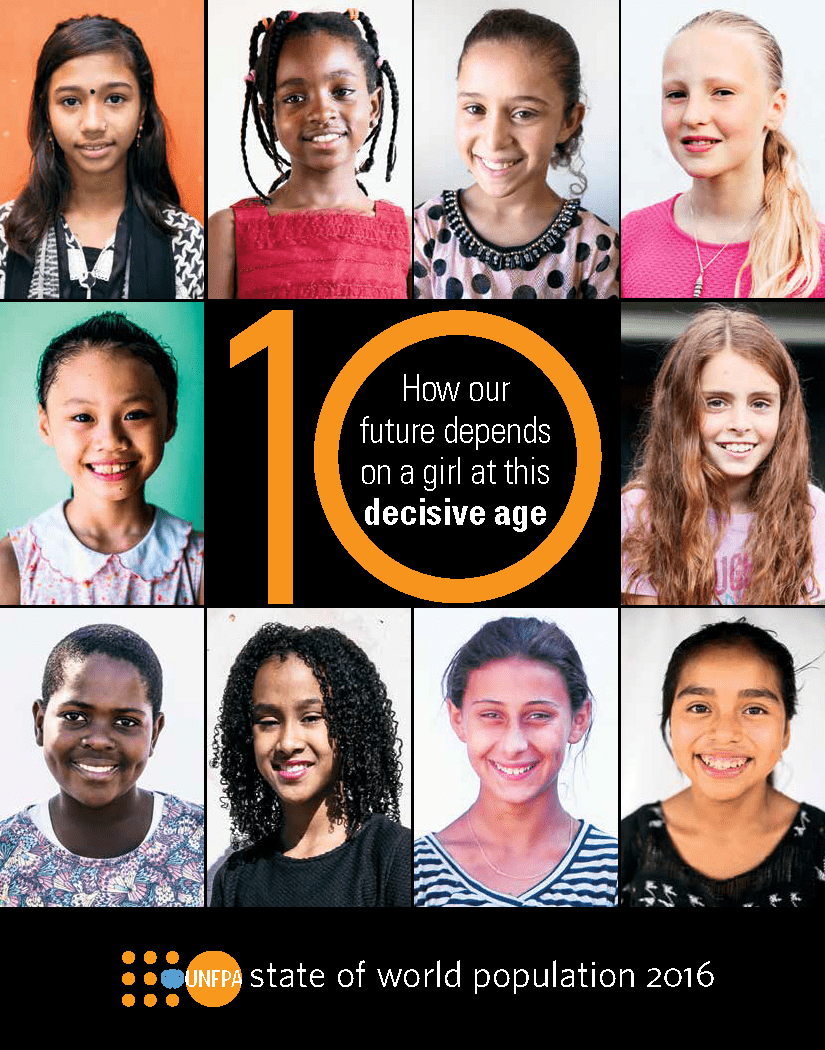The State of World Population 2016
UNFPA’s State of World Population 2016 report shows that empowering today’s 10-year-old girls could yield huge demographic and economic dividends and build better societies.
Manila, 20 October 2016 — HIV/AIDS, teenage pregnancy and child labour are undermining girls’ health, rights and opportunities and threaten the world’s new and ambitious development agenda, warns UNFPA, the United Nations Population Fund, in The State of World Population 2016, released today.
Practices that harm girls and violate their human rights--starting at age 10--prevent them from realizing their full potential as adults and from contributing to the economic and social progress of their communities and nations. Without their contribution, the United Nations Agenda 2030 for Sustainable Development and its accompanying 17 Sustainable Development Goals may never be achieved.
“Impeding a girl’s safe, healthy path through adolescence to a productive and fulfilling adulthood is a violation of her rights,” says Klaus Beck UNFPA Representative in the Philippines. “But it also takes a toll on her community and nation. Whenever a girl’s potential goes unrealized, we all lose.”
Girls who reach adulthood with an education and their health and rights intact could triple their lifetime incomes, thereby fueling progress for generations and entire nations, the report states.
“By ensuring the over 1 million 10 year-old girls in the Philippines get the tools, know-how and opportunities they need to meet their potential, they could each earn over 45 per cent more over the next 15 years,” notes UNFPA’s Beck.
Ten is a pivotal age for girls everywhere, as puberty approaches. In some parts of the world, a girl at this age enjoys limitless possibilities and begins making choices on her education and later life. But elsewhere, girls are seen as commodities to be bought, sold or traded, the UNFPA report shows. She may be forced to marry, pulled out of school and forced to bear children and begin a life of servitude.
“In the Philippines, teenage pregnancy limits far too many girls’ hopes, dreams and aspirations. It also costs the country around P33 billion each year in foregone earnings,” says UNFPA’s Beck.
“By ensuring girls right to education, including age appropriate comprehensive sexuality education and access to youth friendly sexual and reproductive health services and advice, we could improve the lives of hundreds of thousands, reap long term gains, and help ensure the success of 2030 Agenda for Sustainable Development.”
The new development agenda, endorsed by world leaders in 2015, is global blueprint peace, prosperity and a sustainable future to 2030, leaving no one behind. Removing the barriers that hold 10-year-old girls back today will help make sure the agenda is a success, the report argues.
The State of World Population report notes that of the 125 million 10-year-olds today, 60 million are girls who are systematically disadvantaged at the global level as they move through adolescence into adulthood. Girls are less likely than boys to complete formal schooling at the secondary and university levels, are more likely to be in poorer physical and mental health, and will find it harder to get paid jobs.
The challenge now, the UNFPA reports argues, is to scale up these interventions to reach more girls, especially the poorest and most vulnerable, by age 10.
“How we invest in and support 10-year-old girls today will determine what our world will look like in 2030,” notes UNFPA’s Klaus Beck. “With support from family, community and nation, and the full realization of her rights, a 10-year-old girl can thrive and help bring about the future we all want.”
Key global statistics
- Nine out of 10 10-year-old girls live in developing countries, and one in five lives in a least developed country: one in five is in India, and one in eight in China.
- Each year of education delivers an additional 11.7 per cent uplift in wages in later life for girls (compared with 9.6 per cent for men). Yet, 16 million girls between 6 and 11 will never start school. That’s twice the number of boys.
- If all the 10-year-old girls who drop out of school or do not attend school in developing countries completed secondary education, they would trigger a $21 billion annual dividend.
- More than half of the world’s 65 million 10-year-old girls live in the 48 countries with the worst gender inequality.
- Ten per cent of 5-to-14 year-old girls do more than 28 hours of household chores per week, twice that of boys. Three in four girl labourers are unpaid.
- Every day, an estimated 47,700 girls are married before 18.
Key national statistics
- There are over 1 million 10-year old Filipino girls. If their rights and needs are met, they could earn almost 45% more over the next 15 years.
- Investing in and empowering the over 1 million Filipino 10 year-old girls today and over the next 15 years could boost GDP by almost 13% of today’s GDP.
- By age 19, 4 in 10 girls in the Philippines are – or will soon be – mothers.
- P33 billion in earnings are foregone each year through teenage pregnancy. That’s over 1% of GDP (2012)
UNFPA, the United Nations Population Fund, works to deliver a world where every pregnancy is wanted, every childbirth is safe and every young person’s potential is fulfilled.
For more information, please contact: Matthew Taylor: Tel: +63 906 474 9730; taylor@unfpa.org


